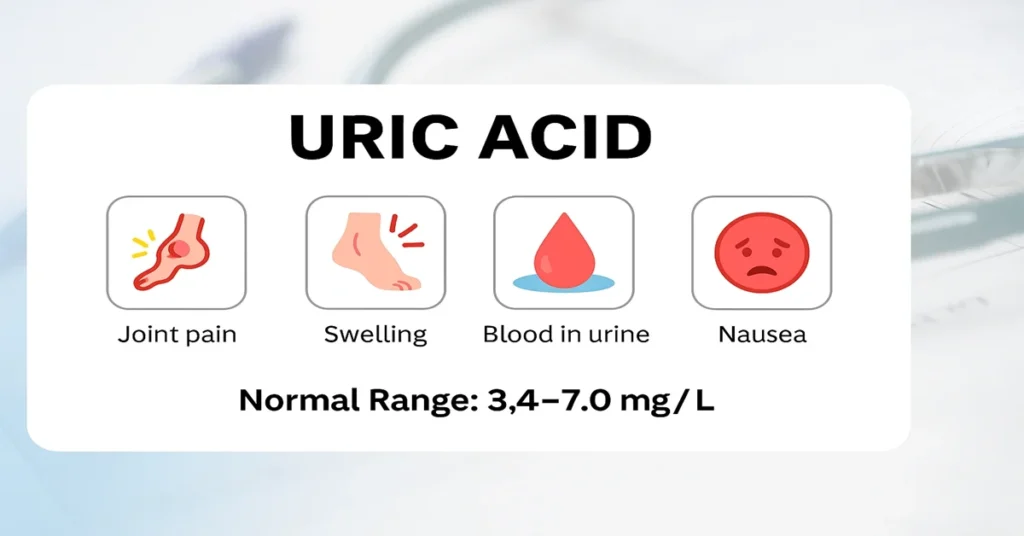What is Uric Acid?
The Uric Acid Test is a blood test that measures the level of uric acid in your body.
Uric acid is a waste product that forms when your body breaks down purines — substances naturally present in your body and in certain foods like red meat, seafood, and organ meats.
This test is commonly used to:
- Detect or monitor gout, a painful type of arthritis caused by uric acid buildup.
- Diagnose or monitor kidney stones or kidney function.
- Check metabolic disorders that affect uric acid production or removal.
Where is Uric Acid Produced in the Body?
- Uric acid is produced mainly in the liver when purines are broken down during normal cell turnover and digestion.
- Once formed, it enters the bloodstream and is filtered by the kidneys, then excreted through urine.
- A small portion is also removed through the intestines.
- If production increases or kidneys fail to excrete properly, uric acid levels rise — leading to hyperuricemia.
Main Functions and Importance
- Uric acid has no direct biological function; it is a waste product.
- However, in small amounts, it acts as a natural antioxidant, helping to protect cells from damage.
- Excess uric acid in the blood can form needle-like crystals that accumulate in joints or kidneys, leading to gout attacks or kidney stones.
Thus, maintaining normal uric acid levels is essential for joint health and kidney function.
Causes of Low Uric Acid Levels (Hypouricemia)
Low uric acid levels are rare but can occur due to:
- Liver disease (reduced production)
- Low-purine diet
- Wilson’s disease (copper accumulation in the body)
- Fanconi syndrome (a kidney tubule disorder)
- Certain medications such as allopurinol or high-dose aspirin
- SIADH (Syndrome of Inappropriate Antidiuretic Hormone Secretion)
Symptoms of Low Uric Acid Levels
Low uric acid itself rarely causes symptoms.
However, when associated with underlying disorders, symptoms may include:
- Fatigue or general weakness
- Mild bone or joint discomfort (in rare cases)
- May be seen as a marker in liver or genetic diseases
Causes of High Uric Acid Levels (Hyperuricemia)
High uric acid levels are much more common and can be due to overproduction or poor excretion by the kidneys.
Common causes include:
- Gout (uric acid crystal buildup in joints)
- Kidney dysfunction (reduced uric acid clearance)
- High-purine diet (red meat, seafood, organ meats)
- Excessive alcohol intake, especially beer
- Obesity or metabolic syndrome
- Dehydration
- Certain cancers or chemotherapy treatments (rapid cell breakdown)
- Psoriasis
- Genetic disorders affecting uric acid metabolism
- High cell turnover conditions like leukemia or hemolytic anemia
Symptoms of High Uric Acid Levels
When uric acid levels rise too high, they can cause gout attacks or kidney problems.
🦶 Gout Attacks:
- Sudden, severe joint pain (often in the big toe)
- Swelling, redness, and warmth in affected joints
🧩 Kidney Stones:
- Sharp pain in the back or side
- Blood in urine
- Nausea or vomiting
Chronic high uric acid can lead to joint damage, kidney disease, or permanent kidney impairment if untreated.
Reference (Normal) Ranges
| Category | Normal Range (mg/dL) |
|---|---|
| Men | 3.4 – 7.0 |
| Women | 2.4 – 6.0 |
| Children | 2.0 – 5.5 |
Note: Normal ranges may slightly differ depending on the laboratory or testing method used.
Sample Type
- Sample Type: Serum (blood sample)
- Tube Used: Red Top (Plain)
Test Preparation
- Avoid alcohol and high-purine foods (red meat, organ meats, seafood) at least 24 hours before the test.
- Stay hydrated, as dehydration may increase uric acid levels.
- Inform your doctor about any medications you are taking, including diuretics or aspirin.
- Fasting is not always required, but some doctors may recommend it for accurate results.
When to Consult a Doctor
You should see a doctor if:
- You experience joint pain, swelling, or sudden gout attacks.
- You have recurrent kidney stones or pain in the back or side.
- Your test results show persistent high uric acid levels.
- You have conditions like diabetes, hypertension, or kidney disease — all of which can worsen uric acid imbalance.
Important Word Explanations
- Purines: Natural compounds found in food and body cells that break down into uric acid.
- Hyperuricemia: A medical term for high uric acid levels in the blood.
- Gout: A painful joint condition caused by uric acid crystal deposits.
- Hypouricemia: Abnormally low uric acid levels.
- Serum: The clear portion of blood used for testing.
- Metabolic Disorder: A condition that affects how the body uses or produces energy.
~END~

